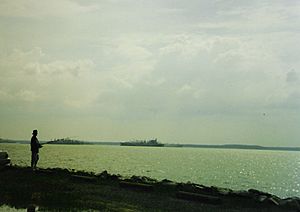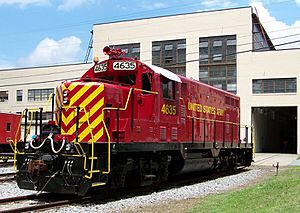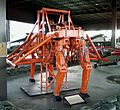Fort Eustis facts for kids
Quick facts for kids Fort Eustis |
|
|---|---|
| Newport News, Virginia | |
|
Location in Virginia
|
|
| Coordinates | 37°09′33″N 76°34′31″W / 37.1593°N 76.5752°W |
| Type | Army Post |
| Site information | |
| Controlled by | United States Army |
| Site history | |
| Built | 7 March 1918 |
| In use | 7 March 1918 – present |
| Garrison information | |
| Garrison | 733d Mission Support Group (USAF) |
Fort Eustis is a military base for the United States Army located in Newport News, Virginia. In 2010, it joined with the nearby Langley Air Force Base. Together, they formed Joint Base Langley–Eustis.
This important base is home to several key Army groups. These include the United States Army Training and Doctrine Command. It also hosts the U.S. Army Aviation Logistics School. The 7th Transportation Brigade is also based here. Another important group is the Joint Task Force – Civil Support.
Other important groups at Fort Eustis include the Army Center for Initial Military Training. The Army Training Support Center (ATSC) is also here. Soldiers at Fort Eustis learn about all kinds of transportation. They also learn about aviation maintenance and how to move supplies.
The main office for the Army Transportation Corps was at Fort Eustis until 2010. It then moved to Fort Gregg-Adams.
In 2005, a law called BRAC changed how military bases were run. Because of this law, the 633d Air Base Wing (USAF) took over managing Fort Eustis. The 733d Mission Support Group now handles the daily operations of the base.
Contents
History of Fort Eustis
Mulberry Island's Early Days
Much of the land that is now Fort Eustis was once called Mulberry Island. English settlers first came here shortly after Jamestown was founded in 1607. A very important event happened near Mulberry Island in 1610. Settlers who had survived a difficult time in the colony were leaving. They were met by Lord Delaware who brought new supplies. He convinced them to turn around and go back to Jamestown.
One early settler was Phettiplace Clouse, who came from Germany in 1608. He was given 100 acres of land on Mulberry Island in 1619. This land is now part of Fort Eustis. He survived a Native American attack in 1622. As a landowner, he helped make laws for the colony.
John Rolfe was also among those who almost left. He had special tobacco seeds. Lord Delaware's leadership and Rolfe's new tobacco helped the colony succeed. By 1612, tobacco became a very important crop. Rolfe later married Pocahontas. For 300 years, Mulberry Island stayed a quiet, farming area. The government bought it in 1918.
American Civil War: The Warwick Line
During the American Civil War in 1862, Fort Crafford was on Mulberry Island. It was part of the Warwick Line. This was a line of defenses built by the Confederate army. It stretched across the Virginia Peninsula to Yorktown.
World War I: Camp Abraham Eustis
On March 7, 1918, the Army bought Mulberry Island. This was to help prepare for World War I. About 200 people living there had to move. Camp Abraham Eustis was then built. It was a training center for artillery soldiers. It also had a school for balloon observation. The camp was named after General Abraham Eustis. He was a military leader in the 1800s. He was the first commander of Fort Monroe.
Camp Wallace
A few miles up the James River, another facility was built in 1918. This was Camp Wallace. It was used for artillery training. It had many barracks and storage buildings.
Camp Wallace was also used for anti-aircraft warfare training during World War II. Later, the Army tested a special aerial tramway there. This tramway was designed to move cargo from ships to shore. It could also move cargo over difficult land.
In 1971, the Army traded land with Anheuser-Busch. The former Camp Wallace land became part of a large new development.
1923: Camp Becomes Fort Eustis
Camp Abraham Eustis became Fort Eustis in 1923. It was made a permanent military base. From 1925, it was also home to Eustis National Forest. The base was used by artillery and infantry units. In 1931, it became a federal prison. It held people who broke laws during Prohibition. When Prohibition ended, the number of prisoners went down. Other groups used the base, including a WPA camp during the Great Depression.
World War II and Modern Times
Fort Eustis reopened as a military base in August 1940. It became the Coast Artillery Replacement Training Center. In 1943, the Caribbean Regiment of the British Army was formed there. In 1946, Fort Eustis became home to the new Transportation School. This school moved from New Orleans. It brought together training for rail, water, and amphibious operations.
Changes made by the Base Realignment and Closure (BRAC) laws affected Fort Eustis. The U.S. Army Transportation School and Center moved to Fort Lee. In 2010, Fort Eustis joined with Langley Air Force Base. They became Joint Base Langley-Eustis. Fort Eustis also gained the U.S. Army Training and Doctrine Command. This happened after Fort Monroe closed.
The Ghost Fleet

A group of old, inactive ships is anchored in the James River. This is near Mulberry Island and Fort Eustis. These ships are part of the U.S. Maritime Administration's National Defense Reserve Fleet. People often call them the Ghost Fleet. Some of these ships are very old and cannot be used again. They can also be a risk to the environment. This is because they still hold fuel and other harmful materials. Since the year 2000, many of these ships have been removed. They are sent to companies that take them apart. Some of these ships were built during World War II.
Transportation Corps Regiment
On July 31, 1986, the Transportation Corps celebrated its 44th birthday. On this day, it also became part of the U.S. Army Regimental System. This change connected current training groups with famous transportation units from the past. For example, the Training Brigade became the 8th Transportation Brigade. This honored the 8th Transportation Group from the Vietnam War. This group was known for supporting many operations. They also developed the "gun truck." This was a strong truck with powerful machine guns.
The symbol of the regiment has the motto "Spearhead of Logistics." This shows a soldier's connection to the Transportation Corps. Officers, Warrant Officers, and enlisted soldiers join the Corps after finishing their training.
General Fred E. Elam was the first Regimental Commander. He named General Frank S. Besson, Jr. as the first honorary Colonel of the Regiment. This was to honor his long service to the Transportation Corps.
U.S. Army Transportation Museum
The U.S. Army Transportation Museum is located at Fort Eustis. It has many U.S. Army vehicles. It also displays other equipment related to transportation. You can see many interesting items from the Army's history there.
Gallery
-
EMD MRS-1 class locomotive that has adjustable gauge, recently painted.
Current Units at Fort Eustis
Many different units are based at Fort Eustis today:
- U.S. Army Training and Doctrine Command
- 128th Aviation Brigade (US Army Aviation Logistics School)
- 7th Transportation Brigade
- 53rd Transportation Battalion (Movement Control)
- 567th Transportation Company (Inland Cargo Transfer)
- Installation Management Command, Atlantic
- Army Center for Initial Military Training
- Army Training Support Center
- Enterprise Multimedia Center
- Army Aviation Applied Technology Directorate
- 597th Transportation Brigade
- U.S. Army Transportation Museum
- 12th Military Police Detachment (CID)
- 93rd Signal Brigade (Strategic)
- 362nd Training Squadron, Detachment 1 Air Force Helicopter Technical School
- Joint Deployment Training Center
- NCO Academy (Aviation Branch ALC)
- US Army Flight Concepts Division
- McDonald Army Community Hospital
- 221st Military Police Detachment
- 3rd Military Police Detachment (K9)
- 74th Engineer Detachment (Dive)
- 86th Engineer Detachment (Dive)
- 511th Engineer Detachment (Dive)
- 569th Engineer Detachment (Dive)
- Port Security Unit 305











